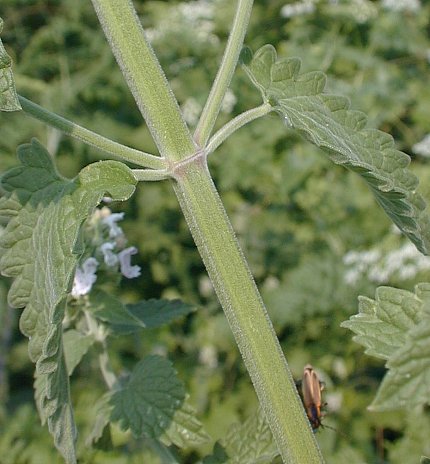Description: This is a perennial wildflower about 1-4' tall that branches occasionally. The light green stems are finely pubescent and 4-angled. The opposite leaves are up to 4" long and 2" across. In shape, they are cordate with blunt tips or ovate with a cordate base. Their margins have large crenate teeth. The upper surface of the leaves is canescent (very finely pubescent) and a reticulated network of veins is clearly visible. The light green petioles are about 1" long, finely pubescent, and 4-angled. The upper stems terminate in dense whorls of flowers on spike-like racemes about 1-6" long. Each flower is about 1/3" (8-9 mm.) long. The corolla is tubular, 2-lipped, and usually dull white; on rare occasions, it is light blue-violet. The upper lip is small and consists of 2 rounded lobes, while the lower lip is large and has 3 lobes. The middle lobe of the lower lip is the largest with a frilly outer edge, while the 2 lateral lobes are much smaller. Usually the lower lip of the corolla has small pink or purple dots. There are 4 stamens that are about the same length as the upper lip, to which they are adjacent. The tubular calyx is light green and finely pubescent. It has 15 nerves along its length and 5 triangular teeth. The blooming period occurs during the summer or early fall, and lasts about 1-2 months. The flowers don't have a noticeable fragrance, although the foliage has a pungent aroma that resembles a combination of thyme and oregano. Each flower is replaced by a seed capsule containing 4 ovoid nutlets. Each nutlet has a smooth curved surface that is lacking in sharp angles. The root system produces abundant rhizomes. This plant often produces clonal colonies from the rhizomes.

Cultivation:
This is an adaptable plant that typically grows in full or partial sun,
moist to dry conditions, and a soil that is loamy, rocky, or gravelly.
Limey soil with a higher than average pH is preferred, but it will grow
in ordinary garden soil. The mature size of this plant is strongly
influenced by moisture levels and soil fertility. It's more drought
resistant than many other members of the Mint family.
Range & Habitat:
The non-native Catnip is a common plant in central and northern
Illinois, but uncommon
or absent in many areas of southern Illinois (see Distribution
Map). Habitats include limestone barrens on bluffs, open
woodlands, weedy meadows, pastures, fence rows, gravelly areas along
railroads, and miscellaneous waste areas. Sometimes this plant is
cultivated in herbal gardens. It is usually found in disturbed areas,
but occasionally invades natural areas where limestone is close to the
soil surface. This species was introduced into North America from
Eurasia.

Faunal
Associations:
The nectar of the flowers attracts long-tongued bees primarily,
including honeybees, bumblebees, cuckoo bees (Epeolus spp., Triepeolus spp.),
long-horned
bees (Melissodes spp.),
and leaf-cutting bees (Megachile
spp.). Other visitors that occasionally visit the flowers
include
Halictid bees, wasps, flies, butterflies, and skippers. The foliage is
one of the food sources for the caterpillars of such moths as Sphinx
eremitus (Hermit Sphinx) and the polyphagous Xanthotype urticaria
(False Crocus Geometer). A Eurasia aphid that is rarely observed in
North America, Aphis
nepetae, also feeds on Catnip. The
pungent foliage is shunned by mammalian herbivores as a food source.
One animal that is strongly attracted to Catnip, however, is the
domesticated house cat. Apparently, a chemical in the foliage produces
a pleasant intoxicating effect in cats, somewhat akin to the effect of
marijuana on humans. As a result, plants in residential areas may
display signs of damage from cats rolling in the foliage.
Photographic Location:
In a partially shaded waste area near a railroad in Urbana, Illinois.

Comments: Catnip is a fairly typical example of the Mint family of plants. While this plant is occasionally cultivated in residential areas, it escapes readily and is more often found in the wild. Catnip is fairly easy to identify, in part because of its distinctive aroma, which is not entirely pleasant to humans. Perhaps the most distinctive feature of Catnip is the appearance of the dense whorls of flowers on the spike-like racemes. These whorls of flowers are crowded closely together and are rather sloppy in appearance. Other members of the Mint family usually produce axillary whorls of flowers above the opposite leaves, or they produce terminal spike-like racemes that are more slender or interrupted. The flowers of Stachys spp. (Hedge Nettles), another genus in the Mint family, have an upper lip that is more similar in size to the lower lip, whereas in Catnip the upper lip of the flower is substantially smaller than the lower lip. Another common member of the Mint family, Teucrium canadense (American Germander), has an upper lip on its flowers that is even more reduced in size than Catnip's. Whereas some members of the Mint family have foliage that is coarsely hairy or devoid of hairs, the foliage of Catnip is finely pubescent (canescent). Furthermore, the leaves of Catnip are cordate at the base, rather than wedge-shaped or rounded.